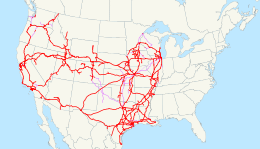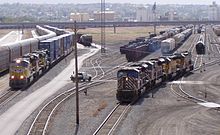 | |

System map (trackage rights in purple)
| |
| Reporting mark | UP, UPRR, UPY |
|---|---|
| Locale | United States from Chicago, Illinois, and cities along theMississippi River to the Pacificcoast |
| Dates of operation | 1862–present |
| Track gauge | 4 ft 81⁄2 in (1,435 mm)standard gauge |
| Length | 32,000 miles (51,499 km) |
| Headquarters | 1400 Douglas Street Omaha, Nebraska |
| Website | www |
The Union Pacific Railroad (reporting mark UP) is a Class I line haul freight railroad that operates nearly 9,000 locomotives over 32,000 route-miles in 23 states west of Chicago, Illinois and New Orleans, Louisiana. The Union Pacific Railroad network is the largest in the United States and is serviced by more than 50,000 employees.[1]
Union Pacific Railroad is the principal operating company of Union Pacific Corporation (NYSE: UNP); both are headquartered in Omaha, Nebraska. Over the years Union Pacific Corporation has grown by acquiring other railroads, notably the Missouri Pacific,Chicago & North Western, Western Pacific, Missouri-Kansas-Texas, and the Southern Pacific (including the Denver & Rio Grande Western).
Union Pacific Corporation's main competitor is the BNSF Railway, the nation's second largest freight railroad, which also primarily services the Continental U.S. west of the Mississippi River. Together, the two railroads have a duopoly on all transcontinental freight rail lines in the U.S.
The current chairman of Union Pacific Corporation is Lance Fritz.[2]
History
The original company was incorporated on July 1, 1862, under an act of Congress entitled Pacific Railroad Act of 1862. The act was approved by President Abraham Lincoln, and it provided for the construction of railroads from the Missouri River to the Pacific as a war measure for the preservation of the Union.[3] It was constructed westward from Council Bluffs, Iowa to meet the Central Pacific Railroad line, which was constructed eastward from San Francisco Bay.
The line was constructed primarily by Irish labor who had learned their craft during the recent Civil War.[4] The two lines were joined together at Promontory Summit, Utah, 53 miles (85 km) west of Ogden on May 10, 1869, hence creating the first transcontinental railroad in North America.[5] Under the guidance of its dominant stockholder Dr. Thomas Clark Durant, the namesake of the city of Durant, Iowa, the first rails were laid in Omaha.
Subsequently, UP took over three Mormon-built roads: the Utah Central Railroad extending south from Ogden to Salt Lake City, the Utah Southern Railroad extending south from Salt Lake City into the Utah Valley, and the Utah Northern Railroad extending north from Ogden into Idaho. It built or absorbed local lines that gave it access to Denver, Colorado, to Portland, Oregon, and to the Pacific Northwest and acquired the Kansas Pacific (originally called the Union Pacific, Eastern Division, though in essence a separate railroad). It also owned narrow gauge trackage into the heart of the Colorado Rockies and a standard gauge line south from Denver across New Mexico into Texas (both parts of the Union Pacific, Denver and Gulf Railway).
UP was entangled in the Crédit Mobilier scandal, exposed in 1872, that involved bribing congressmen and stock speculations. Its early troubles led to bankruptcy during the 1870s, the result of which was reorganization of the Union Pacific Railroad as the Union Pacific Railway on January 24, 1880, with its dominant stockholder being Jay Gould. The new company also declared bankruptcy, in 1893, but emerged on July 1, 1897, reverting to the original name, Union Pacific Railroad.
The corporate headquarters of the Union Pacific Corporation were located in New York City from its initial founding in the 1860s until Drew Lewis became CEO in the mid-1980s. He relocated it toBethlehem, Pennsylvania. Later the headquarters was shifted to Dallas, Texas, before relocating to Omaha to join the operating headquarters.[6]
Revenue passenger traffic, in millions of passenger-miles
| Year | Traffic |
|---|---|
| 1925 | 1,065 |
| 1933 | 436 |
| 1944 | 5,481 |
| 1960 | 1,233 |
| 1970 | 333 |
Source: ICC annual reports
In the tables "UP" includes OSL-OWR&N-LA&SL-StJ&GI; 1925–1944 passenger-mile totals do not include Laramie North Park & Western, Saratoga & Encampment Valley, or Pacific & Idaho Northern, and none of the totals includes Spokane International or Mount Hood. From the ICC annual reports, except 1979 is from Moody's.
| UP | LNP&W | S&EV | P&IN | |
|---|---|---|---|---|
| 1925 | 12,869 | 10 | 3 | |
| 1933 | 8,639 | 4 | 0.4 | (into UP) |
| 1944 | 37,126 | 7 | 0.7 | |
| 1960 | 33,280 | (into UP) | (into UP) | |
| 1970 | 47,575 | |||
| 1979 | 73,708 |
On December 31, 1925 UP-OSL-OWRN-LA&SL-StJ&GI operated 9,834 route-miles and 15,265 track-miles. At the end of 1980, Union Pacific operated 9,266 route-miles and 15,647 miles of track.[7] Moody's shows 220,697 million revenue ton-miles in 1993 on the expanded system (17,835 route-miles at the end of the year).
Union Pacific Corporation
 | |
| Public | |
| Traded as | NYSE: UNP |
| Industry | Transportation |
| Founded | Omaha, Nebraska, United States (1862) |
| Headquarters | Omaha, Nebraska, United States |
Area served
| Western and Mid-Western United States |
Key people
|
|
| Revenue | |
| Total assets | |
| Total equity | |
Number of employees
| 42,884 (2010)[10] |
| Subsidiaries |
|
| Website | www |
| Footnotes / references [10] | |
Union Pacific Corporation is the publicly traded parent company of all UP subsidiaries and operating companies, including Union Pacific Railroad Company (the largest operating company) and Southern Pacific Rail Corporation. Union Pacific Corporation was incorporated in Utah in 1969.[10] Union Pacific Corporation's headquarters are located in Omaha, Nebraska. Lance M. Fritz is the current Chairman, President and Chief Executive Officer.[citation needed]
Facilities
Because of the large size of UP, hundreds of yards throughout its rail network are needed to effectively handle the daily transport of goods from one place to another. To reduce overall emissions, Union Pacific is acquiring a new generation of environmentally friendly locomotives for use in Los Angeles basin rail yards.[citation needed]
Union Pacific San Antonio Intermodal Terminal is a $90 million state-of-the-art intermodal terminal under construction in San Antonio, Texas and was completed in 2009.[11][12]
Active hump yards
Hump yards work by using a small hill over which cars are pushed, before being released down a slope and switched automatically into cuts of cars, ready to be made into outbound trains. Union Pacific's active hump yards include:[13]
- Bailey Yard in North Platte, Nebraska
- Beaumont Yard in Beaumont, Texas
- Davidson Yard in Fort Worth, Texas
- Davis Yard in Roseville, California
- Englewood Yard in Houston, Texas
- Gateway Yard in East St Louis, Illinois
- Hinkle Yard in Hermiston, Oregon
- Livonia Yard in Livonia, Louisiana
- Neff Yard in Kansas City, Missouri
- North Little Rock Yard in North Little Rock, Arkansas
- Pine Bluff Yard in Pine Bluff, Arkansas
- Proviso Yard in Northlake, Illinois, formerly owned by Chicago and North Western Transportation Company
- Strang Yard in La Porte, Texas
- West Colton Yard in Bloomington, California







No comments:
Post a Comment
Feel free to make comments